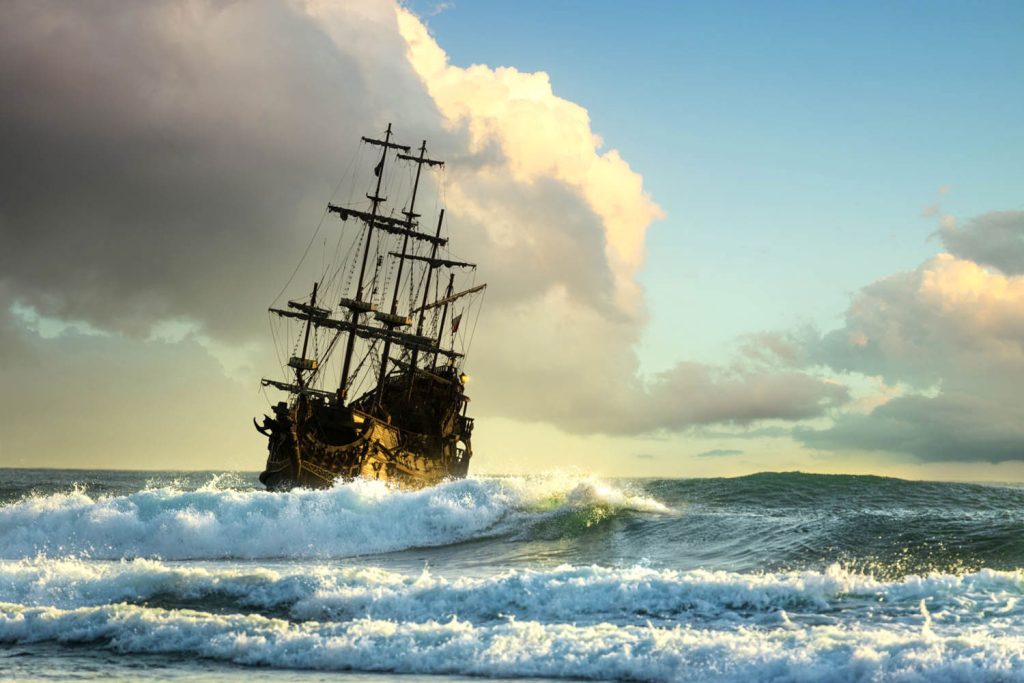One of Caribbean history’s most enduring themes is piracy — starting from the 16th century when brigands first terrorised the region and acquired ill-gotten fortunes. Some 500 years later, pirates are still big business, but now they are mostly employed by the region’s tourist industry in a wide array of boat tours, treasure hunts, and yo-ho-ho jollity. We seem to like pirates, if not piracy in its modern digital meaning, and the Jolly Roger is flown in almost every tourist venue as a symbol of harmless fun.
Yet what historians term the Caribbean’s Golden Age of Piracy is supposed to have ended in the mid-18th century. The European powers — who for 150 years had encouraged their sea captains and adventurers to attack the shipping and colonial settlements of rival nations — grew tired of lawlessness and disruption to trade, and decided to get rid of the pirates. The predators became the prey, as European navies and colonial authorities began to purge the region of organised maritime criminality.
But far from disappearing into obscurity, piracy gained a mythologised glamour, and pirates became unlikely folk heroes. The international success of Charles Johnson’s A General History of the Pyrates (1724) revealed a widespread curiosity about the lives of individuals such as Edward Teach (aka Blackbeard) and Calico Jack (John Rackham) and their exploits.
Johnson’s book was the basis for a long tradition of colourful pirate depictions that includes Robert Louis Stevenson’s Treasure Island and, more recently, the acclaimed Pirates of the Caribbean series.
Something about pirates — or more specifically, a stereotype of historical piracy — appeals to adults and children alike, and the paraphernalia of parrots, pieces of eight, and silly West Country accents remain a staple of fancy dress parties.
Today we are less likely to associate pirates with the murderous maritime predators still at large in the Red Sea than with charmingly inoffensive characters in a cartoon or pantomime.
The attraction of the pirate myth perhaps lies in its celebration of swashbuckling individuality as an antidote to conformism, of adventure as the opposite of drudgery. Add to this the exotic allure of the Caribbean islands and ideas of buried treasure and you have a successful formula for escapism. Their less attractive aspects tend to be downplayed, as pirates are reimagined as honourable Robin Hood types, sharing their loot and robbing the rich.
All this, alas, is nonsense, and the victims of piracy in the 17th and 18th centuries included modest sailors, traders, and settlers as well as the wealthy. The pirates did not have a code of honour, but willingly worked as bounty hunters for the authorities, targeting their brethren.
Henry Morgan gave up attacking Spanish ships to become a slave owner and Governor of Jamaica, with a mission to eradicate piracy. The great majority of pirates in the Caribbean were born in Europe, sought to make a quick fortune, and gave nothing to the region. Their exemplary violence was described in gruesome detail by Johnson and other historians.
And yet piracy’s positive image persisted even into the 19th century, when “the Caribbean’s last pirate” enjoyed a brief and eventful career. Indeed, his popularity remains intact, and this may be in large part because, unlike the earlier European buccaneers, he was a local hero — born in Puerto Rico where he plied his trade.
Very few pirates reached peaceful old age, and Roberto Cofresí was no exception. He and a number of his crew were executed by firing squad in front of El Morro fortress in the port of San Juan, Puerto Rico, on 29 March, 1825 — 200 years ago. In heroic style, he declined the offer of a blindfold and declared defiantly, “I have killed hundreds with my own hands, and I know how to die. Fire!” His reported final words, whether historically accurate or not, fit into the narrative of the fearless outlaw.
The world into which Cofresí was born — on 17 June, 1791 — was very different from that of the Golden Age pirates. The Spanish Empire, whose treasure-laden galleons were plundered by previous generations of British, French, and Dutch brigands, was in terminal decline — and the newly independent mainland republics were no longer a soft target.
The remaining European-owned colonies had reinforced their naval capabilities and were prepared to work together to deter piracy. Puerto Rico, along with Cuba and Santo Domingo, were the last vestiges of Spain’s empire and were struggling economically in an age of regional independence.
Cofresí has even been hailed as a champion of Puerto Rican independence, as well as a benevolent anti-establishment figure
Cofresí, though of mixed European aristocratic heritage, was raised in modest circumstances and was forced to work as a fisherman. Hurricanes, poor harvests, and political unrest worsened living conditions on the island, and it seems that he opted to join a criminal gang, was briefly imprisoned, and escaped.
By early 1823, Cofresí had turned to piracy, working with members of his extended family. The gang operated from the western port of Cabo Rojo but also used the small island of Mona — some 43 miles from Puerto Rico — as a base and were known to frequent the Dominican Republic.
The pirate’s criminal enterprise was small-scale, but extremely busy. Cofresí is thought to have captured and plundered some 70 vessels in two years, but many of these were unarmed trading ships, carrying food and supplies between the Caribbean islands and the mainland.
Alerted by spies at ports, Cofresí’s mini-flotilla of sloops or schooners would intercept non-Spanish vessels, threaten or kill their crews, and steal cash and commodities such as coffee, flour, and leather. These goods were sold illicitly through criminal networks and — so the legend has it — distributed among the poor and needy.
The authorities in the French and British colonies as well as those in the United States were angered by the sudden reappearance of the pirate threat, and a manhunt was organised. Yet Cofresí was seemingly fearless and repeatedly evaded capture, using a stolen six-gun sloop — Anne — as his flagship.
Searches of Cabo Rojo and the surrounding waters yielded nothing until, in early March 1825, a combination of Danish and Colombian sailors located Cofresí and forced him to flee ashore near the Puerto Rican city of Guayama, where he was wounded and arrested.
Cofresí is reputed to have offered a bribe of 4,000 pieces of eight to Guayama’s mayor in return for his freedom, fuelling the legend of a huge hidden treasure hoard.
Cofresí’s death signalled the last gasp of organised piracy in the Caribbean, but was also another step in the creation of a pirate mythology. Today, both Puerto Rico and the Dominican Republic are home to profitable Cofresí-themed industries, encompassing resorts, beaches and even a town, with many associated attractions of buried loot and ghostly apparitions.
He has even been hailed as a champion of Puerto Rican independence, as well as a benevolent anti-establishment figure. Little of this bears careful scrutiny — but then nor do the exploits of Jack Sparrow or Captain Pugwash — the latter being my own favourite pirate!

